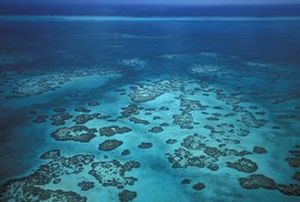PatchReefs
Patch Reefs

Description
Patch Reefs are isolated outcroppings (patches) of coral that are in close proximity to each other but are physically separate from each other because of sand rings around them. They typically are found in shallow lagoons within a larger collective reef. Patch reefs are found in waters with a depth of ten to twenty feet[1] [2] and are typically found in close proximity to land. Coral reef formation is restricted to a solid surface (such as rocky outcroppings and fossil coral ridges)[1]. The patchy appearance for which the reefs are classified is created as a result of the spaces between the solid surfaces. As with all coral reefs, there needs to be sunlight, low turbidity, appropriate water temperature, and low nutrient levels.
Discussion
Formation
Patch reefs are formed on rocky or fossilized coral outcroppings in ten to twenty feet of water.[1] Brain and star corals are typically the first inhabitants of patch reefs, and other hard and soft corals take residence there over time. These corals grow because of the calcium carbonate skeleton that they secrete around themselves. As the coral grow, they grow upward and outward, and each polyp needs to move upward and outward as well. This occurs by laying down more calcium carbonate under themselves.
Morphology and Ecology
Patch reefs have various shapes and sizes due to the variation in species of coral that are present and the size of the hard surface in which they are on. As the reefs mature, more species of coral will be present and increase the variability of the geometry these reefs can have. The sand rings that surround each patch is the result of the herbivorous fish that live in the patch reef as well as the invertebrates that feed on seagrass during the night. Surgeonfish are a good example of herbivores that consume macroalgae. Urchins are the main creatures that feed on seagrass beds. These fish and eat the algae that grows on the coral as well as around the perimeter of the reef (McGinley).
Patch reefs are good at being nurseries for many reasons. Firstly, all reefs are good nurseries because they provide hiding places for young fish and have lots of available biomass for consumption and growth. Secondly, patch reefs are located in shallow water in an inner layer of a reef or atoll. This makes it shielded from the large transient taxa[3] that can be found visiting the edges of reef systems. Thirdly, because patch reefs are typically in lagoons, the water is calmer and it is easier for the initial phases and juveniles to move, hunt, and detect predators.
- Isolation and Fish Migration.
- Fish species in the water layer.
Location
Usually, patch reefs occur within the lagoon behind the barrier or atoll rim[4] and are found in 10-20 feet of water. These locations are quite common in the Caribbean islands and the Bahamas, as well as Bermuda, and the Pacific Islands.
Notes
- ↑ 1.0 1.1 1.2 R. L. Lippson and A. J. Lippson. Life Along the Inner Coast : a Naturalist’s Guide to the Sounds, Inlets, Rivers, and Intracoastal Waterway from Norfolk to Key West. The University of North Carolina Press. 2009. 387-400. Print. Cite error: Invalid
<ref>tag; name "Lippson" defined multiple times with different content Cite error: Invalid<ref>tag; name "Lippson" defined multiple times with different content - ↑ Patch Reef. Florida Museum of Natural History. http://www.flmnh.ufl.edu/fish/southflorida/coral/patchreef.html. 24 Feb 2015.
- ↑ Schroeder, Robert E and Parrish, James D. Ecological characteristics of coral patch reefs at Midway Atoll, Northwestern Hawaiian Islands. Atoll Research Bulletin. Washington D.C.: Smithsonian Press. 2006.
- ↑ Jack Morelock. Reef Types. 2005. http://geology.uprm.edu/Morelock/rftypes.htm. 24 Feb 2015.
McGinley, Mark. The Encyclopedia of Earth, "Coral reef fish feeding behavior in the Caribbean." Last modified 2014. Accessed April 15, 2014. http://www.eoearth.org/view/article/151487/